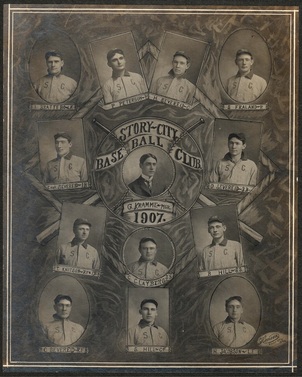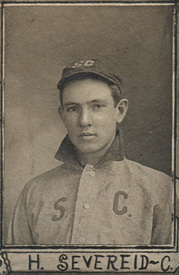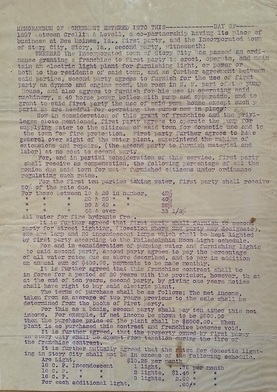 This week we are featuring a photograph of the 1907 Story City Baseball Club for our collection item of the week. The team photo was created by Hanson Studio, a local photography studio in Story City at the time. This is the first Story City baseball club that Hank Severeid played on. Hank references all of these players in his article that was included in the 1940 Story City Herald Anniversary Book. On May 15, 1911 Hank made his major league debut with the Cincinnati Reds. During his major league career, Hank also played for the St. Louis Browns, the Washington Senators, and the New York Yankees.
0 Comments
 Hank Severeid 1907 Hank Severeid 1907 As I mentioned in my last article, P.A. Olson, the editor of the 1940 Story City Herald Anniversary Book included quite a few articles about baseball. The section on baseball wouldn’t be complete without an article about Story City’s most famous baseball player Hank Severeid. And who better to write the article than Hank himself. Olson included an article that had been written by Hank a few years before 1940. Even though Olson titled Hank’s article “Hank Severeid Tells of Rise from Amateur Ranks to Big Leagues” in the Anniversary Book, I believe the theme of the article is more about Hank’s love for the game and the town in which he grew up. Hank begins the article by talking about his first recollection of baseball when the ball grounds were in Marvick’s pasture just west of the Northwestern depot. He recalls a game between Story City and Roland in which the umpire turned to watch a player attempting to steal a base and the ump got hit in the back of the head with the ball. From an early age Hank learned the lesson “always keep your eye on the ball”. Hank was about eight years old and the water boy at the time. By the time that Hank was getting big enough to play “funny man” for the team, the games were played down in the park. According to Hank, the “funny man” was a player who was not good enough to play any position so they let him play anywhere when they were in need of players. Hank needed a uniform, so he bribed his good friend Bert Hill to give him the red uniform he had. Hank had worn many uniforms over the years but he always considered that red one the “honey” of them all. The first Story City team Hank play on included the following players, Bert Hill, Oscar, Chris and Charley Severeid, Hank Jacobson, Carl and Tom Clayberg, Severin Hill, Ira Brattebo, Sig Fraland, with George Kramme as manager and Charley Bartlett as scorer. As he continued on with the team, Hank played on third base and in the outfield regularly. One day when they played Roland, the catcher didn’t show up so Hank tried catching and stuck with that. “You know they say all a catcher needs is a strong back and a weak mind, and sometimes one feels they are right; but seriously, if I had to choose, I would still choose catching, because it’s the most interesting of all positions.” After a couple of years with the Story City team, Hank was hired by the Nevada team. This was the first ball club on which he played every day. After Nevada Hank played with Charles City for a few weeks then went to Burlington of the Central Association in the latter half of 1909. According to Hank, the first professional game he ever saw he played in, which was Burlington against Quincy. Hank went on to play for Ottumwa in 1910 and the following year on May 15, 1911 he made his major league debut with the Cincinnati Reds. During his major league career, Hank also played for the St. Louis Browns, the Washington Senators, and the New York Yankees. To close, I’ll share this section of Hank’s article that shows his love for the game and his hometown. “Many things have happened since we took part in those games at the park, and while it may be a long jump from playing with the Claybergs, Hills, Knudsons, Petersons, Jacobsons, Boyds, Nordskogs and others to playing with Ruth, Johnson, Sisler, Williams, Peckinpaugh, and other major league players, but for sheer joy and pleasure it would be hard to beat the kid day games, and a victory in a World Series game was no sweeter than a 1 to 0 victory over Maxwell.”  This week we are featuring a memorandum of agreement that was donated by the City of Story City which details the forming of the electric company. The company was originally formed in 1897 when the city of Story City entered into this agreement with Crellin & Lovell, a business out of Des Moines. This agreement also establishes an provision for providing street lighting. "One arc lamp and 20 incandescent lamps which shall be kept lighted according to the Philadelphia Moon Light Schedule." According to the EMF Electrical Year Book, Volume 1 published in 1921, in order to make a contract for street lighting it was necessary to know what hours each night that lighting will be required and the total number of hours of lighting to be furnished each year. This was done by agreeing on a definite schedule. The Philadelphia Moon Light Schedule was one of the four most common at the time. Here is the description of the Moon Light Schedule: This schedule provides no lighting when the moon is expected to be bright. Light lamps one hour after sunset until the 4th night of the new moon, also one hour before moonset; extinguish one hour before sunrise, also one hour after moonrise; provide no light at all on the night before, the night of, and the night after a full moon. This schedule results in considerable economy in lighting costs, but makes no allowance for cloudy nights when the moon is obscured. The first street lights appeared in Story City in August of 1898. |
AuthorKate Feil Archives
February 2023
Categories
All
|
 RSS Feed
RSS Feed
